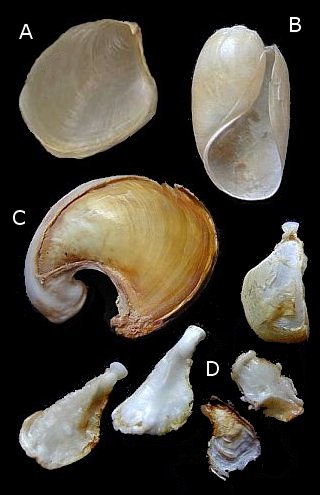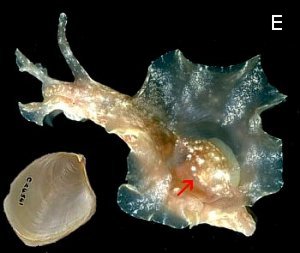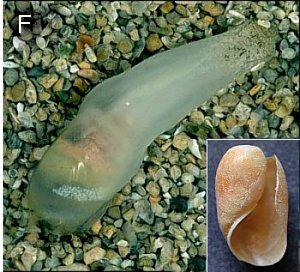
The shell in Sea Hares
Order: ANASPIDEA
PHOTO
A, Aplysia juliana (shell width - 25mm). B, Akera soluta (shell height - 19mm). C, Dolabella auricularia (longest dimension - 67 mm). D, Dolabrifera brazieri 5 shells, to show variability, (longest shell - 15mm). E, Aplysia sp. with parapodia flaps open to show mantle flap covering shell (arrow). F, Akera soluta with inset showing shell.
Photos: B,C,D, Alison Miller. A,E,F, Bill Rudman.
Like most orders of opisthobranch sea slugs, the story of Sea Hare (Order Anaspidea) evolution concerns the gradual loss of the shell.
Akera (B,F) has the most primitive features and retains a relatively large external shell, similar to that found in some sacoglossans and cephalaspidean bubble shells such as Atys.
In species of Aplysia (E) and Syphonota the shell is a flattened lightly calcified plate, which is partially or fully enclosed in the mantle skin (arrow) and forms a weak protective layer over the viscera and the gill. It is clearly now a remnant organ with Sea Hare defence now mainly achieved by colour camouflage and various glandular secretions.
In Dolabella auricularia (C), the ear-shaped shell which gives it its name, is heavily calcified and lies enclosed in the circular shield at the back of the body. Although heavily calcified it is clearly another example of the gradual loss of the shell. Another example is found in Dolabrifera (D), in which the shell is a small, often irregularly shaped plate.
In other genera, such as Stylocheilus and Bursatella, the shell is completely absent.


Rudman, W.B., 2000 (August 27) The shell in Sea Hares. [In] Sea Slug Forum. Australian Museum, Sydney. Available from http://www.seaslugforum.net/factsheet/aplyshell
Related messages
-
Aplysia shell from Majuro
From: David Kirsh, November 29, 2007 -
Shell of Aplysia
From: Yoshiaki J. Hirano, August 30, 2000 -
Shell reduction in the Sea Hares
From: Bill Rudman, August 30, 2000
